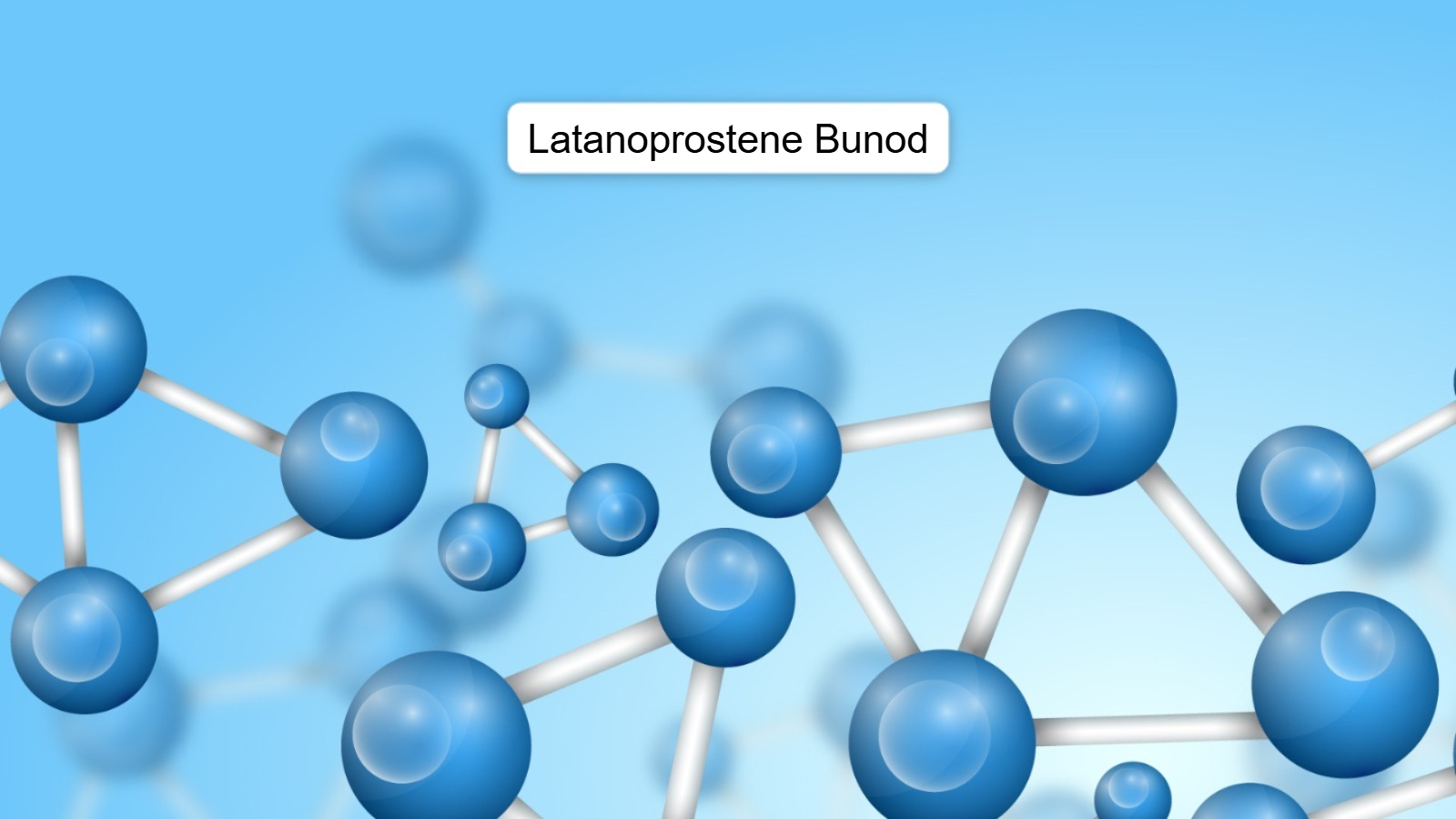
Latanoprostene Bunod is a dual-action prostaglandin analog widely used to manage glaucoma and ocular hypertension. It combines the benefits of enhanced uveoscleral outflow and improved trabecular meshwork function, making it a groundbreaking treatment in reducing intraocular pressure. This guide explores the structure, properties, pharmacology, uses, and safety of Latanoprostene Bunod.
1. Structure of Latanoprostene Bunod
The molecular structure of Latanoprostene Bunod explains its dual mechanism of action and its effectiveness in managing elevated intraocular pressure.
2D Structure
The 2D structure of Latanoprostene Bunod reveals its prostaglandin analog backbone, similar to latanoprost, with an added nitric oxide (NO)-donating moiety. This dual feature enhances aqueous humor outflow through multiple pathways.

3D Structure
The 3D conformation of Latanoprostene Bunod highlights its ability to interact with FP receptors and release nitric oxide, targeting both uveoscleral and trabecular outflow pathways effectively.
2. Names and Identifiers
Latanoprostene Bunod is documented under various names and identifiers in medical and pharmacological databases.
- IUPAC Name:
Isopropyl (Z)-7-{(1R,2R,3R,5S)-3,5-dihydroxy-2-[(3R)-3-hydroxy-5-phenylpentyl]cyclopentyl}hept-5-enoate nitric oxide donor - Molecular Formula:
C27H41NO8 - Molecular Weight:
507.61 g/mol - CAS Registry Number:
1223415-07-3 - Synonyms:
Vyzulta
3. Chemical and Physical Properties
The chemical and physical properties of Latanoprostene Bunod contribute to its dual action and therapeutic applications.
| Property | Details |
|---|---|
| Appearance | Clear, colorless liquid |
| Melting Point | Not applicable (liquid form) |
| Solubility | Soluble in ethanol and methanol; sparingly soluble in water |
| LogP (Partition Coefficient) | ~4.5 |
| Chemical Class | Prostaglandin Analog + Nitric Oxide Donor |
4. Drug and Medication Information
Latanoprostene Bunod is specifically designed to reduce intraocular pressure through dual mechanisms.
Formulations
- Ophthalmic Solution:
- Available as 0.024% eye drops.
Mechanism of Action
Latanoprostene Bunod works by:
- Increasing Uveoscleral Outflow: Similar to other prostaglandin analogs, it enhances the drainage of aqueous humor.
- Improving Trabecular Meshwork Outflow: The nitric oxide donor relaxes the trabecular meshwork, further reducing intraocular pressure.
Dosage and Administration
- Recommended Dose:
- One drop in the affected eye(s) once daily in the evening.
Avoid administering more than once daily, as it may reduce effectiveness.
- One drop in the affected eye(s) once daily in the evening.
Explore a leading manufacturer of APIs.
With over 10 years of expertise, we ensure GMP compliance and provide reliable, high-quality solutions.
5. Pharmacology and Biochemistry
Latanoprostene Bunod’s pharmacology underscores its innovative dual-action mechanism.
Pharmacokinetics
- Absorption:
Rapidly absorbed into ocular tissues after topical administration. - Onset of Action:
Begins reducing intraocular pressure within hours, with peak effects observed within 12 hours. - Half-Life:
~1.5 hours in aqueous humor. - Excretion:
Primarily excreted via urine as inactive metabolites.
Pharmacodynamics
Latanoprostene Bunod improves aqueous humor outflow through both uveoscleral and trabecular pathways. The nitric oxide component enhances trabecular meshwork function, making it uniquely effective compared to single-action treatments.
6. Uses and Side Effects
Primary Uses
- Open-Angle Glaucoma:
Prevents optic nerve damage by lowering intraocular pressure. - Ocular Hypertension:
Reduces elevated intraocular pressure to prevent progression to glaucoma.
Benefits
- Dual mechanism ensures more comprehensive intraocular pressure reduction.
- Proven efficacy with once-daily dosing.
- Minimal systemic absorption, ensuring a favorable safety profile.
Side Effects
Common side effects include:
- Eye redness or irritation.
- Increased pigmentation of the iris (may be permanent).
- Eyelash growth or thickening.
Rare but serious side effects:
- Swelling of the macula (macular edema).
- Severe eye pain or vision changes.
Consult your doctor if side effects persist or worsen.
7. Safety and Hazards
Safety Profile
Latanoprostene Bunod is safe for most patients when used as directed. However:
- Contraindications: Not suitable for patients with hypersensitivity to prostaglandins or nitric oxide donors.
- Pregnancy and Breastfeeding: Use with caution and only under medical supervision.
Chemical Safety

Handling Precautions
- Store in a refrigerator before opening; after opening, store at room temperature for up to 8 weeks.
- Avoid touching the dropper tip to prevent contamination.
Environmental Impact
Latanoprostene Bunod is biodegradable and poses minimal environmental risks when disposed of properly.
Chemignition Laboratory is a globally trusted manufacturer and exporter of Latanoprostene Bunod.
We specialize in APIs and provide complete documentation support including,
- GMP Certificate
- COA
- MSDS
- Stability Data
- Impurity Profile
- ISO 9001 Certificate
Customized packaging and cold chain logistics ensure safe delivery of sensitive APIs worldwide.
We proudly serve pharmaceutical companies across the USA, Europe, Asia, and more.
Partner with Chemignition Laboratory for consistent quality, regulatory compliance, and reliable global supply.
FAQs
IUPAC Name of Latanoprostene Bunod?
Isopropyl (Z)-7-{(1R,2R,3R,5S)-3,5-dihydroxy-2-[(3R)-3-hydroxy-5-phenylpentyl]cyclopentyl}hept-5-enoate nitric oxide donor.
Molecular Formula of Latanoprostene Bunod?
C27H41NO8
Molecular Weight of Latanoprostene Bunod?
507.61 g/mol
CAS number of Latanoprostene Bunod?
1223415-07-3
What is Latanoprostene Bunod used for?
Latanoprostene Bunod is used to treat:
- Glaucoma (Open-Angle): Reduces intraocular pressure to prevent optic nerve damage.
- Ocular Hypertension: Lowers elevated intraocular pressure to prevent vision loss.
How does Latanoprostene Bunod work?
Latanoprostene Bunod works by:
- Increasing uveoscleral outflow of aqueous humor, similar to other prostaglandin analogs.
- Enhancing trabecular meshwork outflow through its nitric oxide (NO)-donating component, which relaxes the trabecular meshwork.
